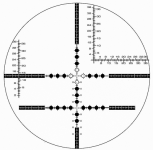Krieger_Tactics:
Long Range Precision Marksmanship - Part 2
INTRODUCTION TO “HOLDING”
MY BACKGROUND
My call sign is Krieger. I am a former Special Forces Soldier (7th Special Forces Group, Ft. Bragg, NC), former security contractor , former instructor (Department of State), and current Unconventional Asset Recovery Agent.
I provide this information in the hope that it will provide a means for a marksman who is looking to improve his or her level of marksmanship and ability.
WRITTEN FOR
While advanced scopes and reticles exist, there are some personnel who still utilize the MIL dot system. This post has been written for this demographic of marksman.
POINTS OF INFORMATION
This post is written from a general assumption that anything not covered in-depth is understood by the reader. Over time I will be returning to this post and explaining many of the points that I don't cover in depth in the next two posts. If you have any questions, if there is something that I don't cover well, if I need to clarify a point or any point, please do not hesitate to reach out and ask for clarification on this thread, or DM me directly.
USE OF MIL DOTS
MIL dot reticles can be utilized to measure objects, estimate range, measure for corrections of round impacts, etc. For those who may not be familiar with the MIL dot reticle, there is one depicted in the first slide attached to this post.
FACTORS TO BE ACCOUNTED FOR IN LONG RANGE PRECISION MARKSMANSHIP
Before a marksman takes a long-range precision shot, there are several factors that need to be accounted for. For now, we’ll only address two of these factors: Windage and Elevation.
WINDAGE AND ELEVATION
-Windage is the calculated effect (left or right of the center of the target) that the marksman projects that the wind and various other factors will have on the fired round during flight.
-Elevation is the calculated deviation that the round will strike above or below the center of the target based on distance from the marksman to the target.
CALCULATING ADJUSTMENTS
The effects of windage and elevation will cause the strike of the round to deviate from center mass of the target. The marksman calculates the adjustments that need to be applied in order to bring the strike of the round back to center of the target.
There are multiple ways to make this adjustment/correction.
I will be discussing one of them; Holds for elevation.
HOLDS
Once the marksman has determined the distance to the target the marksman can utilize the Data On Previous Engagements (DOPE) that has been gathered and recorded in the marksman (sniper in military terms) log book in order to identify the MILs that must be “held” off of the center cross-hair in order to allow/bring the bullet onto the center of the target.
An example of this process is captured below in writing and in the visual aids attached to this post.
Based on a example .308 175-gr trajectory for the M118 (which I used many years ago) a marksman would apply the following MIL holds for a 100 yard zero (https://www.snipershide.com/.../specifications-for.../)
METERS: 100 MIL HOLD: 0.0 point of aim/point of impact
METERS: 200 MIL HOLD: 0.5 higher than center mass/ desired strike of the round
METERS: 300 MIL HOLD: 1.5 higher than center mass/ desired strike of the round
METERS: 400 MIL HOLD: 1.95 higher than center mass/ desired strike of the round
METERS: 500 MIL HOLD: 2.9 higher than center mass/ desired strike of the round
VISUAL EXAMPLES
Slides 2-6 provide a visual graphic of the "holds" as noted above. The center of each target is identified, as well as the location of the cross-hair as it is being held in order to demonstrate visually how each subsequent range necesitates a "higher" hold. These graphics provide you with the ability to note and understand the "holding" process described above.
To note, I created these graphics utilzing powerpoint and thus they are not 100% to scale, however I feel that they are close enough to accomplish the intent here - which is to provide the reader with the ability to visually identify the holding for elevation (range) process.
ALWAYS TRUE?
The provided calculations (holds) are not true for every instance using M118, nor for every M24 sniper weapon system, nor every caliber, nor even every instance using M118.
In fact, there are several factors that influence the hold that a marksman would need to apply. In order to know your "hold" you would have to engage a target at each range and note that in your shooter's log book.
I simply provide this information as a Segway to an introduction to “holds” and to assist in facilitating the understanding of the process.
We will utilize this information in the next post when I discuss reestablishing zero at 500 meters and why a military sniper or tactical competition marksman would do so.
TAKE AWAY
For those who wish to utilize the MIL dot reticle system, being familiar with calculating and applying holds can be an extremely efficient method to engage targets at distances. As we continue to work together in this series of posts I hope to provide you with the means to do so efficiently and effectively.
-Krieger_Tactics
MIL dot reticle system:






Long Range Precision Marksmanship - Part 2
INTRODUCTION TO “HOLDING”
MY BACKGROUND
My call sign is Krieger. I am a former Special Forces Soldier (7th Special Forces Group, Ft. Bragg, NC), former security contractor , former instructor (Department of State), and current Unconventional Asset Recovery Agent.
I provide this information in the hope that it will provide a means for a marksman who is looking to improve his or her level of marksmanship and ability.
WRITTEN FOR
While advanced scopes and reticles exist, there are some personnel who still utilize the MIL dot system. This post has been written for this demographic of marksman.
POINTS OF INFORMATION
This post is written from a general assumption that anything not covered in-depth is understood by the reader. Over time I will be returning to this post and explaining many of the points that I don't cover in depth in the next two posts. If you have any questions, if there is something that I don't cover well, if I need to clarify a point or any point, please do not hesitate to reach out and ask for clarification on this thread, or DM me directly.
USE OF MIL DOTS
MIL dot reticles can be utilized to measure objects, estimate range, measure for corrections of round impacts, etc. For those who may not be familiar with the MIL dot reticle, there is one depicted in the first slide attached to this post.
FACTORS TO BE ACCOUNTED FOR IN LONG RANGE PRECISION MARKSMANSHIP
Before a marksman takes a long-range precision shot, there are several factors that need to be accounted for. For now, we’ll only address two of these factors: Windage and Elevation.
WINDAGE AND ELEVATION
-Windage is the calculated effect (left or right of the center of the target) that the marksman projects that the wind and various other factors will have on the fired round during flight.
-Elevation is the calculated deviation that the round will strike above or below the center of the target based on distance from the marksman to the target.
CALCULATING ADJUSTMENTS
The effects of windage and elevation will cause the strike of the round to deviate from center mass of the target. The marksman calculates the adjustments that need to be applied in order to bring the strike of the round back to center of the target.
There are multiple ways to make this adjustment/correction.
I will be discussing one of them; Holds for elevation.
HOLDS
Once the marksman has determined the distance to the target the marksman can utilize the Data On Previous Engagements (DOPE) that has been gathered and recorded in the marksman (sniper in military terms) log book in order to identify the MILs that must be “held” off of the center cross-hair in order to allow/bring the bullet onto the center of the target.
An example of this process is captured below in writing and in the visual aids attached to this post.
Based on a example .308 175-gr trajectory for the M118 (which I used many years ago) a marksman would apply the following MIL holds for a 100 yard zero (https://www.snipershide.com/.../specifications-for.../)
METERS: 100 MIL HOLD: 0.0 point of aim/point of impact
METERS: 200 MIL HOLD: 0.5 higher than center mass/ desired strike of the round
METERS: 300 MIL HOLD: 1.5 higher than center mass/ desired strike of the round
METERS: 400 MIL HOLD: 1.95 higher than center mass/ desired strike of the round
METERS: 500 MIL HOLD: 2.9 higher than center mass/ desired strike of the round
VISUAL EXAMPLES
Slides 2-6 provide a visual graphic of the "holds" as noted above. The center of each target is identified, as well as the location of the cross-hair as it is being held in order to demonstrate visually how each subsequent range necesitates a "higher" hold. These graphics provide you with the ability to note and understand the "holding" process described above.
To note, I created these graphics utilzing powerpoint and thus they are not 100% to scale, however I feel that they are close enough to accomplish the intent here - which is to provide the reader with the ability to visually identify the holding for elevation (range) process.
ALWAYS TRUE?
The provided calculations (holds) are not true for every instance using M118, nor for every M24 sniper weapon system, nor every caliber, nor even every instance using M118.
In fact, there are several factors that influence the hold that a marksman would need to apply. In order to know your "hold" you would have to engage a target at each range and note that in your shooter's log book.
I simply provide this information as a Segway to an introduction to “holds” and to assist in facilitating the understanding of the process.
We will utilize this information in the next post when I discuss reestablishing zero at 500 meters and why a military sniper or tactical competition marksman would do so.
TAKE AWAY
For those who wish to utilize the MIL dot reticle system, being familiar with calculating and applying holds can be an extremely efficient method to engage targets at distances. As we continue to work together in this series of posts I hope to provide you with the means to do so efficiently and effectively.
-Krieger_Tactics
MIL dot reticle system:
Last edited:



